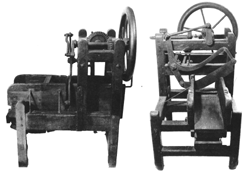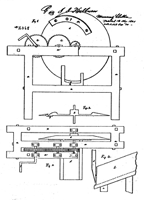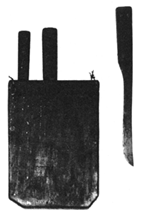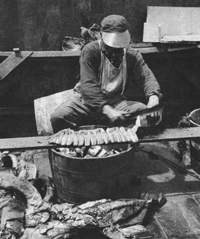 Whalecraft
Whaling
Whalesite
Whalecraft
Whaling
Whalesite


Boarding knife and sheath Length is 29-3/4", length including pole is 48-3/4" Blade is 1" wide and 1/4" thick When cutting in, i.e., removing the blubber from the whale, the blubber was cut by spades, under direction of the second mate, into a six-foot wide strip and hoisted up to the block on the mast by huge tackle and a blubber hook. This huge strip about 14 feet long was called a blanket piece. (see photo at the left and also the description under "Spades"). When the blanket was hoisted as high as it could go,
known as "two blocks" (when the two huge pulleys, or blocks, came together), another blubber hook, blubber toggle or chain of a chain-strapped lower block was attached through a hole cut in it. This hole was cut with a boarding knife. When a strain was put on the second tackle to support the blanket, the hoisted blanket was cut off above the new point of attachment with the boarding knife. The process was known as "boarding", ie, bringing the blanket piece on board. Thus the name of the whalecraft used was a boarding knife. Boarding was the job of the third mate.
The boarding knife was a long, double-edged blade very similar to a sword, mounted on a short wood handle by means of a closed-seam socket forged to the end of the blade. The boarding knife was usually secured by means of a screw or pin through the socket and wood handle. A Turk's head knot was often tied at the base of the blade where it joined the socket. This was to prevent a bare hand from sliding along the oil soaked handle onto the razor sharp blade during use. After steel became widely available in the mid 1800's the blades of boarding knives were made of steel because it would hold a sharp cutting edge far better than wrought iron. When not in use, the boarding knife was kept in a wood case made on board by the whalemen.
Sometimes boarding knives were made from discarded swords or Navy cutlasses, adapted for use as boarding knives, as an economic move.
Mincing Knives 
Mincing knife and sheath Length of the blade is 24-1/4" After the blanket piece was cut into horse pieces (about six
feet long - the width of the blanket - and one foot wide), the horse pieces were taken to the mincing horse. This consisted of 2" planks about 1 ft wide and 3 ft long across a tub to hold the minced blubber. Several wood pegs along the side of the planks kept the horse piece in place while mincing. To facilitate trying out, or boiling the blubber down to extract the oil, the surface area of the blubber was increased by slicing it into thin slices, about 1" thick The thin slices were left attached to the blackskin like the pages of a book attached to the spine. This was then called "books" or "bible leaves". Slicing the horse pieces into bible leaves was called mincing, and was done with a mincing knife.
Photograph by Albert C. Church.
A mincing knife was a long blade about 24" long and 4" wide, only about 1/16" thick, with a wood handle on each end. The top of the thin blade was reinforced with a metal rib across the entire length. The lower edge was sharpened to slice the blubber. Blubber is not easy to cut, and mincing was done with a sideways slicing motion, not a straight plunge downward. A horse piece was placed on the plank and while one man pulled it along the plank with a small hand hook another man sliced it into bible leaves with the mincing knife. When not in use, the mincing knife was kept in a wood case made on board by the whalemen.
It should be noted that in the Dutch, English and Scotch northern whale fisheries blubber was not boiled down into oil on board ship. It was cut into small pieces and stored in casks to be taken back to shore for extracting the oil. The process of cutting the blubber into small pieces and stowing it in barrels was known as "making off" and was done leisurely when the crew was not pursuing whales. The exception was sperm oil, which had to be extracted as soon as possible by boiling the blubber, otherwise it would become a dark, thick mass.
Mincing Machines 
Sowle & Carsley Mincing Machine Height is 42-1/2", width is 27-1/2", length is 33". There was no change to the design of the mincing knife, however some mincing machines were developed to replace hand mincing. These required only one man to load horse pieces into the machine and then turn a hand crank. The bible leaves were more more uniform, also. There was an early U.S. Patent granted to B. Taber of Fairhaven, Massachusettes on August 11, 1821, for a "whale blubber mincing machine". Practically all early patent records were destroyed in a fire in 1836 at the Patent Office, so details of this invention are not known. Another early U.S. patent was granted to W. Ball of New York City on April 25, 1822, for a "knife for cutting up blubber," but those records were also lost in the fire in 1836.
There were at least four other patented mincing machines, but one was used more than any other, and serves to illustrate these whaling tools. This mincing machine is illustrated above, and was patented by George W. Sowle and William Carsley of
New Bedford, Massachusettes on Oct 6, 1843, (U.S. Patent No. 3,290). The mechanism of their hand-cranked machine automatically fed the horse piece forward the proper distance on a conveyor belt at the bottom of a wooden trough. It was then sliced nearly through by a drawing stroke of a mincing blade. The mincing blade returned to its initial position and the horse piece moved forward for the next slice This alternating action was accomplished by turning the hand crank which was geared to a large flywheel to maintain smooth action. The conveyor belt and mincing blade were linked to the crankshaft by means of gears and a cam.
Patent drawings for Sowle and Carsley mincing machine.
The conveyor belt was made of leather with strips of wood secured across its width. Nail points projected up from the wood strips to grip the blubber as it moved through the machine. Any reverse motion was prevented by a ratchet.
The mincing blade was bolted to a frame fixed directly to a jointed crank mechanism The claim in the patent was for the method of fixing the knife blade directly to the crank. This can be seen in the photo above.
Other patents for mincing machines were similar and are not discussed in detail. The patent drawings and a brief summary description will suffice. If more detail about a particular mincing machine is desired, please send me email with your request
G. and J. J. Kilburn of Fall River, Massachusettes received a U.S. Patent on Nov. 16, 1841, (U.S. Patent No. 2,368) They called their invention the "Fly-Mincer". The patent claims specified:

We do not claim the knife on the wheel or the opening in the face of the wheel, nor the beveled edge of the wheel, as these have long since been known and used separately, as also the hopper; but What we do claim as our invention, and desire to secure by Letters Patent, is ----- Making the back face of the wheel beveled toward the periphery, and the beveled opening through which the blubber passes after it has been cut, in combination with the curved knife, and these thus combined in combination with the arrangement of the hopper, so that the part cut shall not be entirely severed from the mass in the hopper, all substantially as herein specified.
Patent drawings for G. & J.J. Kilburn mincing machine
Patrick Cunningham of New Bedford patented a hand-cranked mincing machine Sept. 28, 1880, (U.S. Patent No. 232,691). The motion of this machine was continuous and bible leaves were cut by a spiral knife with a radius increasing from the center outward. This gave the drawing action required Cunningham explained:
It will be observed that the knife makes a complete revolution at each cut, and the whole length of the knife-edge passes through the blubber laterally, while the vertical cut, on account of the spiral shape of the knife, is only about one-eighth of said length of the knife-edge.
Whale-blubber is of a spongy nature, and in order to slice it in pieces of uniform thickness it is necessary to have about the above-mentioned proportion of drawing stroke to vertical cut. It is also necessary that the slices should be of uniform thickness in order that the oil may render properly.
The knife is made to take a spiral or screw form on its shaft, so that the edge of the knife in making the cut may follow the motion of the feed, thus preventing the crowding of the blubber against the knife.
Patent drawing for the P Cunningham mincing machine is shown above
J. Morrison Hunter of New York City also patented a blubber cutting machine on May 8, 1860, (U.S. Patent No. 28,179) he called his device a "circular cutter mincing machine". This cutter did not mince blubber into bible leaves, but sliced completely through it This hand-cranked machine included a stationary clamp through which the edge of the cutting wheel passed, continually cleaning the blade and sharpening it. There was no need to adjust the height or position of the blade as it wore smaller due to sharpening. Hunter explained:
My machine gives a very rapid drawing cut, and the machines heretofore used for this purpose are unable to obtain these conditions to an equal extent. My machine, worked in the manner first described, allows the knife to revolve at pleasure and clear itself of fat without compelling any positive rotary motion on the ascent. It allows the cutter to be placed to work at any depth required, as the disk wears away, without any adjustment of other portions of the machine. It allows the slices to be moved to one side by the rotation of the disk without affecting their arrangement in close contact with each other. It compels the disk to rotate with a uniform velocity during its descent, which may, by properly proportioning the parts, be made that which is found most desirable in practice; and it keeps the cutting-edge always keenly sharpened and very true.
Patent drawings for J. M. Hunter blubber cutter
Henry H. Ricketson of New Bedford was granted a patent posthumously through his administratrix, Lydoriann Ricketson, on Dec 14, 1852, (U.S. Patent No. 9,478) for a device that cut blanket pieces into horse pieces. It was very similar to mincing machines, and as a machine to process blubber it is included here. Ricketson utilized "two or more" spiral knives that cut through the blanket, passing through fluted slots in the rollers supporting the blanket. In his patent, Ricketson said:
In the process of removing blubber from a whale it is generally taken from him in the shape of a strip, which is cut or peeled from the whale in a spiral or helix extending around him from head to tail, the carcass being rolled over and over during the process of cutting and removing the blubber from the whale. This piece generally varies from
nine to eleven inches in thickness, and is very tough and firm in its consistence. These long strips are termed by whalers "blanket-pieces," and they are usually cut up or rendered into what are termed "horse-pieces," which are themselves reduced or sliced so as to become what are termed "books," which, when formed, are pitched into a large tub, where they are [then] boiled for the purpose of removing the oil.
Patent drawing (partial) for H.H. Ricketson blubber cutting machine
The operation of reducing the blanket-pieces to horse-pieces, or cutting them up by lateral cuts through them is performed by the machine in question, and for this purpose it is necessary that the knives should cut with a drawing stroke, and that the cutting-edge should advance in the direction in which the blanket-piece may be in movement; otherwise it could not cut the blanket-piece in the required manner. If a cutting-wheel composed of a single plane plate be used, the forward movement of the blanket-piece would have to be stopped during the time the knife was passing through a strip of blubber. As soon as one of the spiral slicing-knives above mentioned has passed through the blubber from one side of it to the other, the other one takes it in rear of the cut so made and makes another drawing and gradually-descending cut through it.
Ricketson's machine was not practical and it is doubtful that it was ever used. Simply maneuvering the huge blanket piece into position in the machine would have been almost impossible, and the size of the machine on a crowded deck would not have been practical.
The mincing machines had mechanisms that could jam or break, and they required maintenance. Sharpening the blades was more difficult, and required more time than the hand mincing knife. They were also much more expensive than having several mincing knives on board. Mincing machines were not popular; hand mincing was the preferred method.
Leaning Knives 
Leaning knives were simply large butcher knives used to trim small bits of flesh, called "lean" by whalemen, from the blubber to prevent discoloring the oil when tried out. This was a job for the blubber room gang. Also, because the blubber of blackfish and smaller whales was much thinner, leaning knives could be used to mince it rather than using mincing knives. Leaning knives were kept in a wood case made on the whaleship by the whalemen.

Cutting blackfish blubber with leaning knives Photograph by Albert C. Church
Back to top of this page
